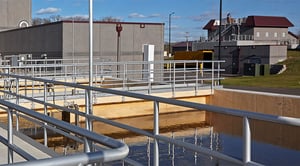Challenge
The City of Detroit Lakes in northwest Minnesota had a 60-year-old wastewater treatment facility that was tasked with treating 2.2 million gallons per day of wastewater to support a growing population. A study by the Minnesota Pollution Control Agency (MPCA) and Pelican River Watershed District (PRWD) revealed that phosphorus levels from various sources were affecting Lake St. Claire. MPCA directed the City to reduce the phosphorous content of the wastewater effluent entering the lake by 94%.
Related: How One City Tackled Stringent New Wastewater Regulations
Solution
After evaluating 12 alternatives, Detroit Lakes Public Utilities Commission and SEH determined that leaving the plant and discharge in place was the best long-range choice when paired with innovative technologies to meet system demands and reduce nutrient loads. The $30 million improved treatment system includes a membrane biological reactor (MBR), a process that uses membranes to physically separate solids, replacing traditional clarification and filtration processes.
By embracing innovation, the new wastewater treatment plant meets one of the most stringent phosphorus limits in Minnesota. In fact, the facility’s performance has surpassed expectations, with lower operational costs than anticipated. This is now one of the most innovative wastewater treatment facilities in Minnesota, serving as a model for communities faced with similar challenges.
Awards
- 2022 Engineering Excellence Grand Award | American Council of Engineering Companies, Minnesota Chapter (ACEC-MN)
Project Name
Wastewater Treatment Facility Planning, Design and Construction Administration
Location
Detroit Lakes, Minnesota
Client
Detroit Lakes Public Utilities
Features
- Reduces phosphorus discharged by more than 94%, from 1 mg/L to 0.066 mg/L
- Utilizes membrane bioreactor (MBR) equipment, largest of only seven MBR facilities currently in operation in Minnesota
- New influent pumping and screening
- Ultraviolet light disinfection
- 2 mm fine-screening and grit removal
- Solids handling involving membrane thickening
- Aerobic digestion process
- Reused and repurposed existing structures to reduce costs
- Produces high-quality effluent for reuse applications
- New office and lab spaces
- Secured over $18 million in grant dollars
Services
- Wastewater engineering
- Architecture
- Civil engineering
- Community development
- Construction services
- Geotechnical engineering
- Mechanical engineering
- Electrical engineering
- Marketing communications
- Mechanical/electrical engineering
- Natural resource scientists
- Structural engineering
- Environmental engineering

.png?width=113&name=SEH_Logo_RGB%20(1).png)
